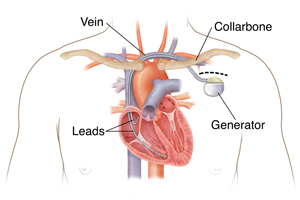Implantable Cardioverter Defibrillator (ICD)
An implantable cardioverter defibrillator (ICD) is a device that's placed permanently inside your body. It monitors the speed and pattern of your heartbeat (heart rhythm). If this rhythm becomes too fast and possibly dangerous, the ICD sends out electrical signals. There are 2 types of ICD electrical signals:
Both of these methods help bring the heart's rhythm back to normal. The ICD is put inside your body during a minor surgical procedure called implantation. In most cases, this takes about 1 hour.
How do I get ready for this procedure?
-
Follow any directions you're given for not eating or drinking before surgery.
-
Follow your healthcare provider's instructions on what medicines to take beforehand.
-
You may be asked to shower with antibacterial soap the night before your procedure and the morning of the procedure. Ask your provider if they want you to use a certain kind of soap.
-
Your provider may ask you to use clean bed sheets and pajamas the night before the procedure.
What happens during the procedure?

The ICD is usually put on the left side of your chest. Putting the ICD in your body (implantation) doesn't require open heart surgery. This means your chest cavity won't be opened. Only the skin over the chest is opened. During the procedure:
-
You'll be given medicine to help you relax.
-
The healthcare provider makes a cut (incision) in the skin below your collarbone. This creates a “pocket” to hold the ICD.
-
The provider threads a wire (lead) through the incision into a vein in the upper chest. With the help of X-ray monitors, the provider guides the lead into one of the heart’s chambers. Depending on how many leads your ICD has, this process may be repeated to guide leads into other chambers.
-
The provider attaches the leads to the heart muscle so they'll stay in place. The leads will be tested to make sure they're placed correctly.
-
The battery (generator) is attached to the leads. Then the provider places the generator in its pocket under the skin.
-
The provider may start (induce) a fast heart rhythm to test the ICD.
-
Antibiotic solution is used to clean the pocket.
-
When everything else is done, the incision is closed. This will be done with stitches that dissolve, medical glue, or staples.
Other implantation sites
In some cases, the ICD can be put in a different part of the body. This could be on the right side of the chest or on the left side under the muscle. A newer subcutaneous ICD is available. For this, the generator is placed below the left armpit. A wire is tunneled under the skin over the breastbone (sternum). This ICD doesn't need any lead to be in the heart itself.
What happens after the procedure?
You will usually stay in the hospital overnight. While you're in the hospital, your heart’s signals are watched to see how the ICD is working. You can go home when your condition is stable. Once you get home:
-
Follow your discharge instructions to care for your incision. Watch for signs of infection (see "When to call your healthcare provider" below).
-
Follow any special instructions to care for the side of your body where your ICD was implanted. Your healthcare provider may tell you not to raise that arm above the shoulder for a certain amount of time. You may also be discharged with a sling or other device to help keep your arm from moving after the procedure.
-
You’ll likely have bruising at the incision site. This is normal and will go away as the incision heals.
-
You may have pain at your implantation site. Talk with your provider about the best pain management options for you. If you do have pain, it typically goes away in a few days to a week.
-
You can likely return to your normal routine soon after implantation. Ask your provider when you can go back to work and what limits you may have.
-
You'll be told not to drive for a certain amount of time. Follow your healthcare provider's instructions on when you may drive. Commercial driving with an ICD isn't allowed by most state laws. This is because of the risk of losing awareness due to life-threatening heart rhythms that this device is designed to treat. Talk about your situation with your healthcare provider.
-
Carry an ICD Wallet ID card with you. This helps medical providers treat you appropriately. Metal detection security devices in public places may detect the metal in your ICD, although they won't damage it. Showing your card may save you some inconvenience. Consider also getting a medical ID bracelet for additional security and convenience.
-
See your healthcare provider for follow-up visits as advised.
Call 911
Call 911 right away if you have:
When to call your healthcare provider
Call your healthcare provider if any of the following occur:
-
Signs of an infection, such as:
-
Fever of 100.4ºF (38ºC) or higher, or as directed by your provider
-
Fluid leaking from the incision
-
Redness, swelling, or warmth at the incision site
-
Twitching chest muscles
-
Pain around your ICD that gets worse, not better
-
Bleeding from your incision
-
Swelling in the arm on the side of the incision site
-
Severe swelling of the incision site (bulging up like a golf ball)
-
You receive a shock from your ICD
-
Your device generator feels loose under the skin or wiggles in the pocket
Online Medical Reviewer:
Ronald Karlin MD
Online Medical Reviewer:
Stacey Wojcik MBA BSN RN
Online Medical Reviewer:
Steven Kang MD
Date Last Reviewed:
3/1/2024
© 2000-2024 The StayWell Company, LLC. All rights reserved. This information is not intended as a substitute for professional medical care. Always follow your healthcare professional's instructions.